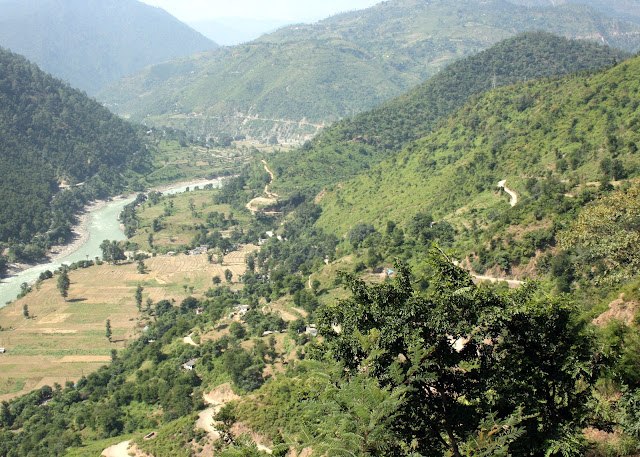 |
| River, Hill and Dale Views - Road to Champawat and Pithoragarh. |
 |
| Typical Bazar in an Indian Hill Station. |
The world and its brother knows about the popular Himalayan Hill
Stations of Shimla, Mussoorie, Manali, Dharamshala amongst others.
It used to be said that if someone took an evening stroll on the Mall at Shimla for a couple of hours, in May or June, one would meet a third of one’s friends from Delhi.
It used to be said that if someone took an evening stroll on the Mall at Shimla for a couple of hours, in May or June, one would meet a third of one’s friends from Delhi.
 |
| Initial View of most Hill Stations . |
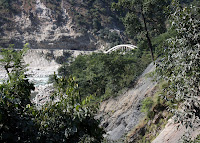 |
| The Road, the Bridge and the Streams. |
With more a better roads and the internet for information, tourists have started to look beyond the traditional summer watering holes and have started venturing further afield, but the fact remains that during the peak season, most of the popular hill stations are overcrowded, dirty and not good value as hoteliers predictably raise tariffs.
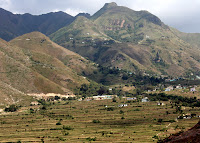 |
| Hills and Dale Enroute to Champawat. |
 |
| The Landslide Jinx Strikes. |
An avid traveler, looking for newer and less crowded destinations, can still find havens of comparative peace and quiet in the Himalayas. These places nestled among forests, greenery and somewhat off the beaten track, can provide peace and quiet along with beautiful vistas and friendly people. Champawat and Pithoragarh in the Kumaon region of Uttarakhand are two such places which can be visited and used as base camps for excursions into surrounding areas.
The intrepid author, tired of Delhi’s traffic and pollution, set out alone early one morning, with no particular destination in mind but with an amorphous thought of visiting his favorite weekend get away at Corbett National Park.
 |
| One Bulldozer Good! Two Bulldozers Better!. |
Fate deemed otherwise, with floods having ravaged Uttarakhand, Corbett was unapproachable so one turned towards Pant Nagar. Confabulations with local bus and truck drivers indicated that most roads had some sort of blockage due to flooding. The only highway open was the strategic one to Pithoragarh.
In the true spirit of adventure, the car's nose was pointed towards Champawat
and Pithoragarh.
A long drive but a scenic one. Fields and plains, giving way to the foot hills, green forests, small towns and cantonments, lakes and streams, and, onwards into the mountains.
A long drive but a scenic one. Fields and plains, giving way to the foot hills, green forests, small towns and cantonments, lakes and streams, and, onwards into the mountains.
 |
| The Market Square at Champawat. |
The flood jinx struck again, and, half way there, landslides blocked the roads. The border roads organization does a sterling job of keeping the roads open and in this case too, timely action with battalions of bulldozers resulted in roads opening out after a fashion, of course with hours of delay at each choke point, a lot of it due to indiscipline and selfishness of local drivers.
The tired adventurer reached an almost asleep Champawat at past 10:00 pm.
Champawat, the erstwhile capital of the Chand Rajas is a typical small hill town, perched at 1600 mt. above a green valley.
Champawat acquired some notoriety in the early nineteen hundreds, when the area was the stamping ground of the Man-Eater named the Champawat Tigress. Officially credited with 436 human kills.
She was shot by the famous Jim Corbett in 1907. His account of hunting the Tigress in his famous book ‘The Man-Eaters of Kumaon’ makes for fascinating reading.
 |
| Baleshwar Temple, Champawat. |
While hotels and infrastructure are in short supply and of variable quality, there is still enough here to tarry a day or two to visit the temples and other attractions in and around the area.
Baleshwar, an ancient temple dedicated to Lord Shiva, was built by the early kings of the Chand dynasty in the town of Champawat. It is easily the most artistic temple of the region.
 |
| A Beautifully Carved Panel, Baleshwar. |
The temple once had intricate structural features and a sanctuary with a mandap. The intricate carving still visible on the ceilings and some panels of these temples is an evidence of their ancient glory and excellence.
There are two other shrines in the temple compound of Baleshwar, one dedicated to Ratneshwar and other to Champawati Durga.
The temples seem to have been influenced by South Indian Architecture and have been declared an Indian National Heritage Monument.
 |
| Carved Panels, Baleshwar, Champawat. |
 |
| Human Scale |
The carvings on the outer panels of the Baleshwar complex temples reminded the author of the sculptures at Khajuraho, with some erotic scenes depicted.
There are may other small but popular shrines in and around Champawat.
The small temple of 'Nag Nath', dedicated to the Serpent God Seshnag, is particularly noteworthy.
Like most temples in the Mountains, in India, The Nag Nath Temple and most others are built on a very human scale. There are good reasons for type of architecture.
 |
| Nagnath Temple |
The small temple of 'Nag Nath', dedicated to the Serpent God Seshnag, is particularly noteworthy.
Like most temples in the Mountains, in India, The Nag Nath Temple and most others are built on a very human scale. There are good reasons for type of architecture.
 |
| Beautiful Carved Celing, Bhaleshwar Temple. |
 |
| 'Naula' a covered water source and storage |
Near the Baleshwar Temple complex, another building worth visiting is a covered 'Naula' or water storage and source. All over the northern hills there are these buildings that store water fro intermittent springs and rain water runoff, for use during the dry season, a fine example of 'Green' thinking and old, area specific, water management systems; which have fallen into disuse. The 'Naula at Champawat is particularly noteworthy and is adorned with beautiful stone carved panels.
 |
| Road to Pithoragarh. A village by the River. |
As the lofty Himalayas provided enough perspective to dominate mere mortals, temples in these locations did not feel the need to do so. They, therefore, are built to more human scales, unlike temples in the plains, which are built with soaring cupolas in order to dwarf humans with their height and awe them with spritual and temporal power.
Of course the fact that the Himalayas are subject to strong earthquakes, from time to time, probably has some effect here.
Two days on, the author and his trusty steed were bound for Pithoragarh, about 75 km. from Champawat. The road is narrow in parts but is in good shape. There are ample views of mountains, forests, valleys and rivers cutting their way through the mountains on to the plains.
Care has to be exercised while driving, as this road has many curves and hair pin bends and it is easy to unexpectedly come upon a truck or bus which has broken down in the middle of the road.
Pithoragarh, a delightful small town and cantonment, is located in a
narrow valley, about 5 kms. long and 2 km. wide. At an elevation of 1650 mt.
Pithoragarh is a district headquarters. The main town is now somewhat crowded
and dirty, though not so much as the other popular hill destinations. The cantonment
area, however, is beautiful, clean and well laid out.
Travellers are well advised to use hotels like The Zara Residency, that are located in the cantonment area, if for nothing else but the openness. The owner of the hotel can organize most adventure tour activities and also arrange for permissions to land at the Pithoragarh Airstrip, for chartered flights.
 |
| Pithoragarh Cantonment. |
Travellers are well advised to use hotels like The Zara Residency, that are located in the cantonment area, if for nothing else but the openness. The owner of the hotel can organize most adventure tour activities and also arrange for permissions to land at the Pithoragarh Airstrip, for chartered flights.
The district is often described as a ‘Mini Kashmir’. While this may be
somewhat of a hyperbole, the area is endowed with great natural beauty and
resources.
 |
| Lake near Pithoragarh. |
Tourist attractions abound in the form of mountains, forests, rivers, lakes and
historic temples.
This area has great potential for developing into an
adventure tourism destination. Already many specialist adventure tour agencies are
offering high altitude treks, white water rafting, hang gliding, fishing and
pilgrimage tours to the area.
You are advised to visit the place before
the advent of the invading hordes.
 |
| Kamaksha Temple |
Pithoragarh has a long history. It was one of the main centers of power during the Chand Rajas reign in Kumaon. It has many monuments and temples and a magnificent fort was also constructed in Pithoragarh.
 |
| Holy Flame, Kamaksha |
 |
| Erotic Carvings Nakuleshwar Temple. |
The Nakuleshwar temple carvings, too, are evocative of the Khajuraho erotic carvings.
 |
| Alpine Meadows and Homes, Pithoragarh. |
Many places like Chandak, Munsyari, Dharchula provide opportunities
for trekking, mountaineering, hang gliding and water activities like canoeing, white
water rafting.
 |
| Mountain Stream, Pithoragarh. |
Of particular import for trekking, is the magnificent Panchachuli Glacier in the Darma valley. Sobla 134 km from Pithoragarh is the start of the 40 km trek to the Panchachuli Glacier, this trek combines great natural beauty with the Alpine meadows and Snowcapped mountains.
 |
| The Panchauli Glacier Trek in Dharma Valley |
There is also a tough trek to Mount Adi Kailash also known as Chhota
Kailash in Pithoragarh district. The trek begins and ends at Tawaghat. The
first few days of the trek follow the same route as the pilgrimage to Mount
Kailash and Mansarovar. The last village on this trek, Kuti, has intricately
engraved doors and windows, some rock salt mines and is home to an ancient fort,
which as legend has it, was used by the Pandavas of Mahabharata fame.
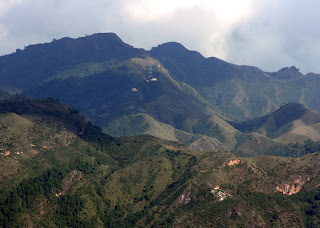 |
| An Evening view of the Lofty Mountains. |
 |
| A Peach Tree in full bloom. |
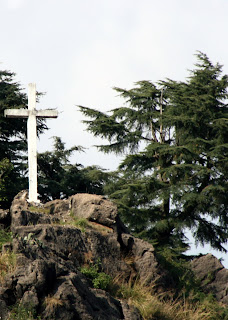 |
| Cross in the Wilderness, Pithoragarh. |
The traditional eating pattern of the region consists of two meals comprising Aloo Gutka/Sabji, potato cubes tempered with a Tibetan herb called jumboo, red chillies, cumin seeds and asafetida. Boiled rice, rotis and chutney either of apricots or green chillies and coriander or of small pomegranates known as daadim.
Food is usually cooked in iron vessels, over a charcoal or wood fire,
which adds great flavor, lentil based preparations are often cooked overnight in
the slow heat of a dying wood fire.
A variety of soya bean, black in color called bhatt, and a rust brown lentil called gahat, form typical ingredients of Kumauni food. The soya bean providing the main protein intake. Buckwheat (a coarse grain) known as muduva is used in the interiors of the region. Traditional sweets include semolina based halwa, pooas (sweet pan cakes), and singhals.
Unfortunately, the author could not find any good restaurants serving traditional Kumauni food and was able to taste it only through the good offices of the hotel manager who was kind enough to bring him a home cooked meal.
 |
| Home is where the heart(h) is!. |
Apart from an incident with an old Sardarji reversing a Tractor Trailer on to the bonnet of the author’s car, fortunately with minor damage, the 500 km. journey home was uneventful and one returned with many memories and also a camera card filled with photographs to refresh them when they faded.
 |
| A Farewell to the Hills with a Song and Prayer. |







Why do I get the feeling in some of those photos that you just stopped and took a deep breath and felt cool healing air entering your lungs. Like the air that comes from being up and out of the city and that mountains embrace.
ReplyDeleteYou know a similar question was asked by another friend of mine asked a similar question on email and my reply was,
ReplyDelete"Yes Pithoragarh and especially the areas around it are remarkably pollution free, in fact if you could bottle and sell the air of some of those Alpine meadows, you would be a rich man".
Some folks prefer Beaches and some the 'Bright Lights' on a holiday or excursion, but give me mountains any day, anywhere in the world. Mystical.
Truly a well written narrative from the soul for other thirsty souls! What in the mountains converts us material mortals into pure spiritual souls I know not but the transformation is magical. Write on my friend, from the deep recesses of your heart while we waysiders lap up the words that from the soul come.
ReplyDeleteThanks Pradeep, Yes I agree, the Himalayas have a mystic call for me. More so than Beaches, Cities and Plains. There is something about their majesty that uplifts us mere mortals.
ReplyDeleteAnil